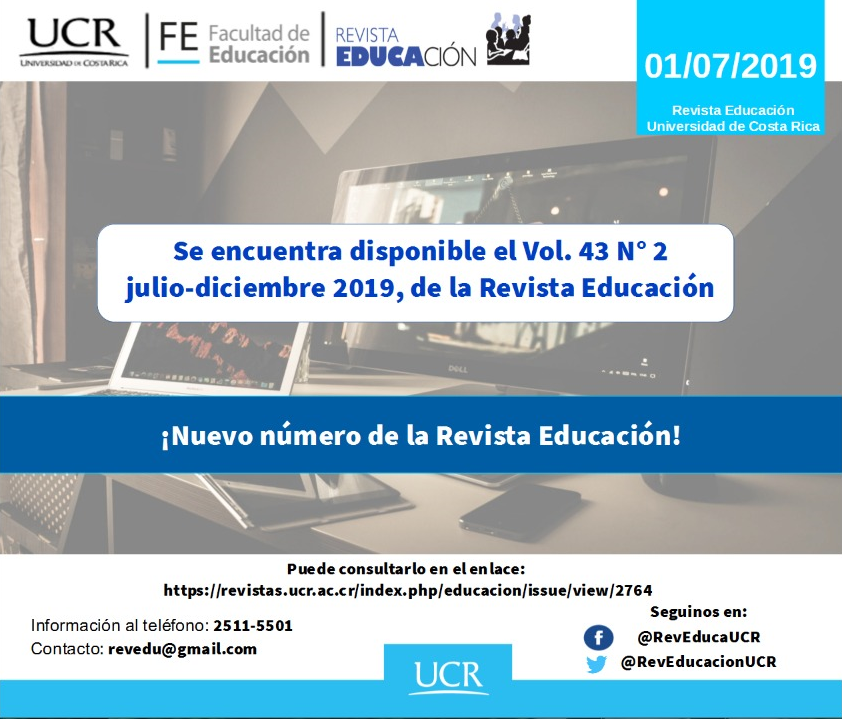Abstract
This article addresses how the concept of finding the area of a quadrilateral has been traditionally taught to student teachers majoring in Middle School Mathematics Education at the Catholic University of Santísima Concepción (UCSC) in Chile. It is important to note that Education Majors already possess a notion as to how to teach the concept of finding the area of a quadrilateral which we refer to here as their didactic cultural heritage. This study observes didactic cultural heritage as a product of the Chilean Educational School System and proposes a baseline to monitor and compare results among these students at UCSC and compare student views with fundamental elements of Didactic Theoretical Situations (DTS) according to Guy Brousseau (1986). Current teaching strategies are based on axiomatic structures and reproductive problem resolution and consider teaching as based on a traditional organizational method. However, students have also proposed more practical teaching methods applicable to real-life scenarios which involve increased teacher-student interaction and additional ways of representing diverse geometric objects, reflexive type exercises and active “devolution” alluding to a more conceptual mastery of area. The results conclude that teaching methods tend to be repeated and Education Majors, in this case, focusing on Middle School Math, will ultimately teach a concept according to how they were taught that same concept in the classroom when they were students in Middle School.
References
Acosta, M., Monroy, L. y Rueda, K. (2010). Situaciones a-didácticas para la enseñanza de la simetría axial utilizando Cabri como medio. Revista Integración. Universidad Industrial de Santander, 28(2), 173 - 189.
Ávalos, B. (2004). La Formación Docente Inicial en Chile. Santiago: Unesco.
Bacon, L. (2009). Construction négociée par la triade de formation en stage d’un savoir-enseigner les mathématiques au primaire. (Tesis Doctoral). Universidad de Montreal, Canadá. Recuperada de https://papyrus.bib.umontreal.ca/xmlui/handle/1866/5328.
Ball, D., Hill, H. C. y Bass, H. (2005). Knowing Mathematics for Teaching: Who Knows Mathematics Well Enough To Teach Third Grade, and How Can We Decide? American Educator, 29(1), 14-17.
Ball, D., Thames, M. y Phelps, G. (2008). Content Knowledge for Teaching: What Makes It Special? Journal of Teacher Education, 59(5), 389-407.
Brousseau, G. (1986). Fondements et méthodes de la didactiques des mathématiques. Recherches en Didactique des Mathématiques, 7(2), 33-115.
Brousseau, G. (2007). Iniciación al estudio de la teoría de las situaciones didácticas. Argentina: Libros del Zorzal.
Brousseau, G. (2013). Glossaire de quelques concepts de la théorie des situations didactiques en mathématiques. Recuperado de https://bit.ly/2JJ3B48
Clemens, S. R., O'daffer, P. G. y Cooney, T. J. (1998). Geometría. México: Addison Wesley.
Chavarría, J. (2006). Teoría de las Situaciones Didácticas. Cuadernos de investigación y formación en educación matemática, 1(2), 1-10.
CNA-Chile. (19 de diciembre de 2018). Comisión Nacional de Acreditación. Recuperado de https://www.cnachile.cl
Chevallard, Y. (1999). El análisis de las prácticas docentes en la teoría antropológica de lo didáctico. Recherches en Didáctique des Mathématiques, 19(2), 221-266.
D'Amore, B. (2005). Bases filosóficas, pedagógicas, epistemológicas y conceptuales de la Didáctica de la Matemática. México: Reverté.
D'Amore, B. (2011). Didáctica de la Matemática. Bogotá: Cooperativa Editorial Magisterio.
D'Amore, B., y Fandiño, M. (2002). Un acercamiento analítico al triángulo de la didáctica. Educación Matemática, 14(1), 48-61.
Facultad de Educación. (2011). Planes y Programas Pedagogía Media en Matemática. Concepción, Chile: Ediciones UCSC.
Facultad de Educación. (2012). Programa de Estudio Geometría en el Plano y su Didáctica. Concepción, Chile: Ediciones UCSC.
Godino, J., Batanero, C. y Font, V. (2003). Fundamentos de la enseñanza y el aprendizaje de las matemáticas para maestros. Granada, España: Universidad de Granada.
Gravemeijr, K. y Terwel, J. (2000). Hans Freudenthal, un matemático en didáctica y teoría curricular. Curriculum Studies, 32(6), 777 - 796.
Johsua, S. y Dupin, J. (2005). Introducción a la Didáctica de las Ciencias y las Matemáticas. Argentina: Ediciones Colihue.
Lamoureux, A. (2006). Recherche et méthodologie en sciences humaines. Quebec. Beauchemin.
Martínez, S. (2014). Recursos para la formación inicial de docentes de educación básica. Santiago, Chile: Proyecto Fondef D09 I1023.
MINEDUC. (2004). Reglamento sobre evaluación docente. Recuperado de https://bit.ly/2YyWhMp
MINEDUC. (2012). Programas de Estudio. Recuperado de https://bit.ly/2HwW9GA
MINEDUC. (2013). Perímetros y áreas de figuras geométricas. Santiago, Chile: Ministerio de Educación. Recuperado de https://bit.ly/2WToIVe
MINEDUC. (2018). Informativo: Valores 2018 para BRP y asignaciones de Carrera Docente. Recuperado de https://bit.ly/2w3kw9n
Morales, H. (2017). La teoría de las situaciones didácticas como sustento teórico en la formación de docentes. En UCSC (Ed.). La didáctica como fundamento para la formación inicial y continua de docentes. Tendencias, enfoques y avances (p. 67-88). Concepción, Chile: Editorial UCSC.
OCDE. (2006). PISA 2006. Marco de la evaluación. Conocimientos y habilidades en Ciencias, Matemáticas y Lectura. España: Santillana.
Paillé, P. y Mucchielli, A. (2013). L'analyse qualitative en sciences humaines et sociales. París: Armand Colin.
Perrenoud, P. (2000). Mobiliser ses acquis: où et quand cela s’apprend-il en formation initiale? De qui est-ce l’affaire? Recherche y formation, (35), 9-23. Recuperada de https://www.persee.fr/doc/refor_0988-1824_2000_num_35_1_1667
Quivy, R. y Campenhoudt, L. V. (2006). Manuel de recherche en sciences sociales. París: Dunod.
Reyes, C., Dissett, L. y Gormaz, R. (2013). Geometría. Chile: Maval.
Rodriguez, G., Gil, J. y García, E. (1999). Metodología de la investigación cualitativa. Málaga, España: Aljibe.
Winsløw, C. (2009). First Years of Teaching. En R. Even y D. L. Ball (Eds.). The Professional Education and Development of Teachers of Mathematics (pp 93-101). New York: Springer.
Winsløw, C. (2013). The transition from university to high school and the case of exponential functions. EN F. Arzarello (Presidente), Eighth Congress of European Research in Mathematics Education. Conferencia llevada a cabo en el congreso CERME 8, Manavgat-Side, Antalya - Turquía.







